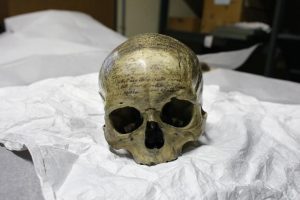
Descartes, the great French intellectual, had a busy life… not to mention the adventures that befell his bones after Descartes died.
Trained by the Jesuits at La Flèche, Descartes was a soldier – he took part in several campaigns in different armies during the Thirty Years’ War – and, at times, a brawler, until he turned to philosophy and mathematics. He renewed Western philosophy, half-rotted by centuries of scholastic tradition, and, fearing repression by the Catholic Church – even though his reasoning included the existence of God – he went into voluntary exile in tolerant Netherlands, where he published most of his works, some of which, Philosophical Meditations, for example, ended up condemned by the Catholic Church in the Index of banned books; the situation in the Netherlands should not be over-idealised either: “Even in Holland Descartes was subjected to vexatious attacks,” wrote Bertrand Russell on the subject, “not by the Roman Church, but by Protestant fanatics. His views were said to lead to atheism, and he would have been persecuted had not the French ambassador and the Prince of Orange intervened”.
The poor health of the founder of rationalism as a young man led him to get into the habit of staying in bed until late. Although, of the various occupations that can be done in bed, Descartes adopted that of meditation. And from these reflections later emerged methodical doubt, “I think, therefore I am”, reason as a fundamental guide to thought – taking as a model mathematical reasoning guided by logic – and also analytical geometry.

And what happened to his bones? Descartes was buried in Stockholm in 1650, where he was in residence after entering the service of Queen Christina of Sweden a few months earlier. The cold northern climate, coupled with the early mornings that the queen’s Spartan habits imposed on Descartes, bent his health and brought him to his grave in short order. Sixteen years later, his remains were stolen by order of the French ambassador, taken to France and buried in the church of St. Geneviève in Paris – now no longer extant. From there they were exhumed during the French Revolution and taken to the Panthéon, to be dug up once more and buried in the Abbey of Saint-Germain-des-Prés. However, during this last transfer, it was discovered that Descartes’ skull had disappeared, only to turn up years later at an auction in Sweden, apparently in the possession of the chemist Jöns Jacob Berzelius, who had bought it for a handful of coins. After some vicissitudes, the skull (without the lower jaw, which did not return from Sweden) rests today, separated from the other remains, in the Musée de l’Homme in Paris… only for some years now it has been suspected that the revolutionary chaos meant that the remains unearthed from St. Geneviève were not really those of Descartes. “The Cartesian tendency to place mind over matter (mind over body) thus finds its metaphorical crowning,” wrote Russell Shorto, author of Descartes’ Bones. The skull (the representation of the mind), subjected to a series of increasingly complex scientific analyses and considered authentic, is preserved as a relic in the Museum of Man. As for the body, the trail is abruptly interrupted and lost in oblivion. Perhaps this is as it should be. Dust thou art, and unto dust shalt thou return”.
Antonio J. Durán, Crónicas Matemáticas, Crítica, Barcelona, 2018.
Russell Shorto, Los huesos de Descartes, Duomo ediciones, Barcelona, 2009.

Leave a Reply